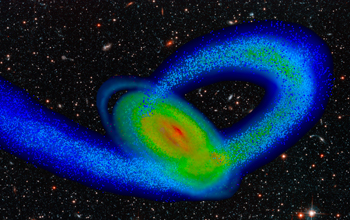Multimedia Gallery
Sagittarius galaxy impacts Milky Way's disk
A computer simulation showing the impact of the Sagittarius galaxy on the disk of
the Milky Way. This impact had a major influence on the development of the Milky Way's spiral arms; this spiral structure is clearly visible in the image. Also shown is the Sagittarius Stream, a long stream of stars and dark matter stripped from the Sagittarius galaxy by the gravitational pull of the Milky Way.
Research by astronomers at the University of California, Irvine, has found that the Sagittarius galaxy, a dwarf galaxy loaded with dark matter, has careened twice through our much larger home galaxy in the past 2 billion years--according to telescope data and detailed simulations--and is lined up to do so again. As the galaxies collide, the force of the impact sends stars streaming from both in long loops. These continue to swell with stars and are gradually tugged outward by the Milky Way's rotation into a familiar ringed arm.
To learn more about this research, see the UC-Irvine news story Milky Way's spiral arms are the product of an intergalactic collision course. [Research supported by National Science Foundation grant AST 06-07377.] (Date of Image: August 2011)
Credit: Erik Tollerud, Chris Purcell and James Bullock, University of California, Irvine
See other images like this on your iPhone or iPad download NSF Science Zone on the Apple App Store.
Images and other media in the National Science Foundation Multimedia Gallery are available for use in print and electronic material by NSF employees, members of the media, university staff, teachers and the general public. All media in the gallery are intended for personal, educational and nonprofit/non-commercial use only.
Images credited to the National Science Foundation, a federal agency, are in the public domain. The images were created by employees of the United States Government as part of their official duties or prepared by contractors as "works for hire" for NSF. You may freely use NSF-credited images and, at your discretion, credit NSF with a "Courtesy: National Science Foundation" notation.
Additional information about general usage can be found in Conditions.
Also Available:
Download the high-resolution JPG version of the image. (7.3 MB)
Use your mouse to right-click (Mac users may need to Ctrl-click) the link above and choose the option that will save the file or target to your computer.



